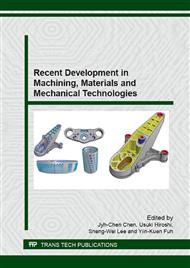p.369
p.375
p.381
p.387
p.391
p.398
p.404
p.410
p.416
The Machinability of CFRP with Cutting Movement of End-Milling
Abstract:
Recently, carbon fiber reinforced plastics (CFRP) are expected to be used more in the aerospace and automotive industries, because of their outstanding lightweight material characteristics and tensile strength [1][2]. Underlying this are problems closely related to improvement of the earth’s environment. However, a mechanical property is influenced by the difference in the distribution state of the carbon fiber, and the adhesion intensity of the binding material. Moreover, they have the characteristic of intense anisotropy, strength wise depending on the orientation of the carbon fibers [3][4]. Therefore, CFRPs are considered difficult-to-machine materials [5], because the surface finish deteriorates according to the carbon fiber orientation. Establishing the optimal cutting conditions to solve such problems also from an economical viewpoint is essential. In our study, end milling operations of different carbon fiber orientation CFRP composite material were investigated with three kinds of different helix angle end mills. Evaluations were based on the surface finish, cutting force and cutting temperature. Moreover, the relationships between the carbon fiber orientation and the machining operations were determined. We earlier evaluated the machinability from the relationship between carbon fiber orientation and tool helix angle by down-cut milling to solve these problems [6]. In this study, machining operations of different carbon fiber orientation CFRP composite material were investigated with three kinds of different helix angle end mills by up-cut milling. Evaluations were based on the surface finish, cutting force and cutting temperature. Moreover, the results of this experiment were compared with the results of down-cut milling.
Info:
Periodical:
Pages:
391-397
Citation:
Online since:
July 2015
Authors:
Keywords:
Price:
Сopyright:
© 2015 Trans Tech Publications Ltd. All Rights Reserved
Share:
Citation:


